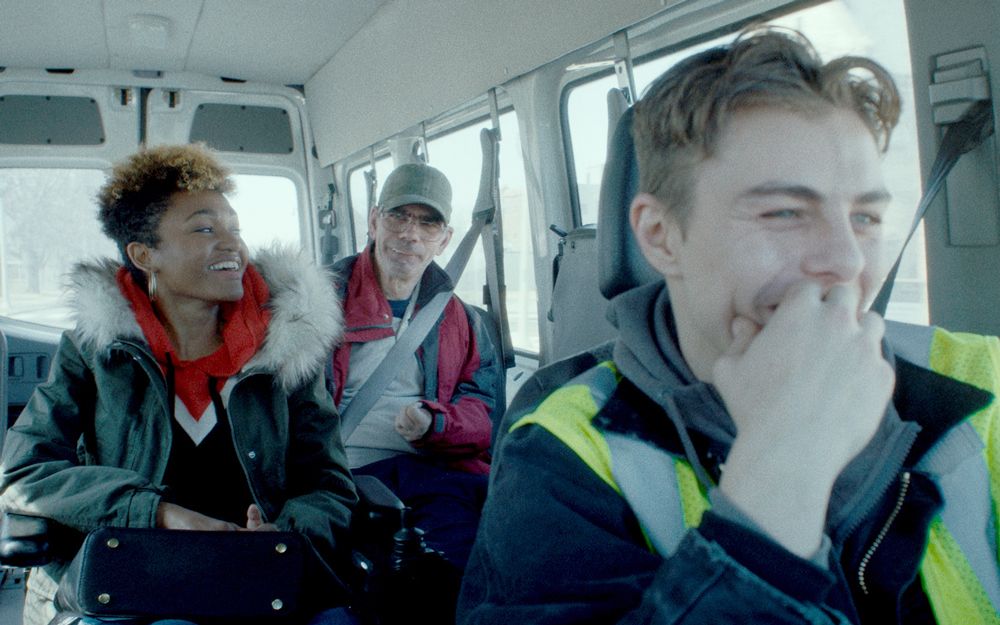It is unusual to see a director in action when you haven’t been on the set of one of their films, but it’s fair to say that as Kirill Mikhanovsky somehow juggled a phone on the side of his head to conduct this interview while rushing towards his gate to check-in for his flight to Los Angeles earlier this week, nearly waylaid by an accident on the road that led to especially heavy traffic, I got a sense of the patience, focus and good humor that yielded his magical second feature “Give Me Liberty.”
“This interview is getting funnier and funnier by the moment, right?” Mikhanovsky asks, shortly after he’s informed he’ll have to check a bag when he’s about to step onboard his flight. “Okay, you see, getting on this plane is exactly how this film was made.”
Clearly, Mikhanovsky thrives in chaos, whether it’s in speaking passionately and eloquently about “Give Me Liberty” when in danger of missing his flight or making a film against all odds that explodes with energy from bringing together a number of easily combustible elements, drawing upon his days of driving a MedEvac around the icy streets of Milwaukee in the winter to shuttle around people with disabilities. With co-conspirator Alice Austen, the director puts a comic spin on his time behind the wheel by spending a day with Vic (Chris Galust), a harried driver who already has trouble making his route when he’s prevailed upon to take elders from his Russian grandfather’s community center to a funeral along with his passengers with special needs, leading to complaints from all to drive faster, most vociferously Tracy (Lauren “Lolo” Spencer), a young African-American woman with ALS.
At a time when there’s as much unrest outside the van as there is inside, as one of the many obstacles Vic encounters over the course of 24 hours is running into protests reflecting the very real racial divide in Milwaukee in the wake of unjust police shootings in the city (well-documented in Erik Ljung’s “The Blood is at the Doorstep”), “Give Me Liberty” breaks through as an enormously entertaining celebration of how our differences can actually unite us as every person’s individual strengths – and eccentricities – contributes to the collective might necessary to get through the day. Even if Benh Zeitlin weren’t involved as one of the film’s executive producers, you’d be reminded of “Beasts of The Southern Wild” as Mikhanovsky conjures the spirit of community with a cast of nonprofessional actors and verve that rivals how hard Vic is pressing his foot against the gas pedal.
If “Give Me Liberty” becomes a portrait of grace under pressure, it extends to what went on behind the scenes where Mikhanovsky and Austen weathered countless fits and starts on the road to putting together such a genuinely unique production, including the devastating collapse of a deal with a notable distributor offering a proper budget just before filming was set to begin. Whatever resources were lost the filmmakers turned towards their advantage as the raw energy and emotion of what’s being captured takes precedence over how it is and in featuring the magnetic Spencer and Galust — yet another remarkable find by New York-based casting director Jennifer Venditti, who saw him in a bakery buying a cake for his grandfather, and did not know the van-driving skills he had accumulated as an electrician would come in handy — “Give Me Liberty” boasts that exhilarating feeling of discovery.
With the film now opening around the country, including this week in Los Angeles, Mikhanovsky spoke about overcoming the many obstacles to get “Give Me Liberty” ready to roll, having the confidence to decide to move forward at the now-or-never moment and the responsibility of giving the city of Milwaukee a world-class film that the entire community could be proud of.
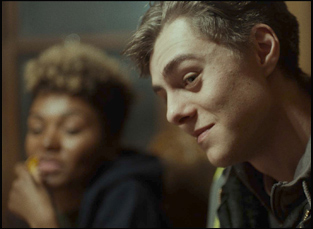
As I was attending college, I had many odd jobs and I was trying to keep myself afloat financially and one was driving the medical transport van for nine months. It was the hardest job I ever had for many reasons. It was winter. It was slippery. I didn’t know the city. I would get lost all the time. My English was not up to speed. And it was hard to face the reality of the clients I had with disabilities [where] just watching their pain and suffering every day in and day out was just a constant reminder of the unfairness of the world. I felt not only a professional, but human responsibility trying to help them and do the best I could. But I was constantly late — there was no GPS [then], and I was a well-meaning scrub.
Though this was a low-end job [where] I was driving long hours in the dead of winter, there were a lot of funny tragicomical accidents and incidents – [I remember one night] at midnight, it was really dark and I had five clients to take home, to deliver to their homes from a party, and I started driving very slowly because snow was falling and it’s those sticky, big flakes. They would completely block the window and I couldn’t see a thing. I was driving at a snail’s pace and the dispatch was gone by the time I arrived at the first location, so I couldn’t see what streets I was on because they were completely covered with snow. I had to stop the vehicle, climb up the sign post and wipe the snow off to read the name of the street. And as I was climbing down, I dropped my keys accidentally in the snow and before I knew it, I had to be crawling all around, looking for the keys while five clients were waiting inside. I felt profoundly ashamed for making their tough lives tougher, [but the whole experience] was in retrospect one of the most important experiences of my life as a human and as a director.
I discovered my Milwaukee and my America through that job. [Driving] just gives you a perspective on how diverse it is, how economically/socially uneven it is and we talk about Milwaukee, which is one of the most segregated cities in America, if not the most segregated and I believe [amongst] my generation of immigrants in the ‘90s, I was probably one of the few people who really had that insight because other people of my generation just wouldn’t venture into those parts of town. So I considered myself to be privileged, frankly, and I learned so much about life and my new home, my new country and I took that experience with me. I didn’t know exactly what I would do with it.
In 2006, I actually thought of going back to the experience and I just simply did not find the world that I cherished in my memory, and I thought the project was not meant to happen until I met my partner and collaborator, a prominent American playwright and novelist Alice Austen. I came to the reading of one of her plays and we began to work on a sci-fi thriller script that had been written and needed a new pair of eyes. I approached her with that offer to work together — and I had just gotten back from a project that didn’t pan out. I spent five years building a Cuban film in Cuba and it collapsed five weeks before the shoot and it left me completely devastated emotionally, psychologically, professionally, financially. I lost everything and I came back to Milwaukee to lick my wounds and get my bearings together – to eat my mother’s soup. [laughs] Alice and I met and we started working on this other thing with a budget of $45 million – not exactly the most practical thing for two screenwriters in Milwaukee, but one thing led to another and at some point I remember a few months into the screenwriting process, I suggested we make a film in Milwaukee because it has such character and that we use those stories of that well-meaning screwup of a driver in the streets of Milwaukee as a starting point for something that continued and ended up being entirely fictional.
So it’s not an autobiographical project by any stretch of the imagination, but in the process for both of us, “Give Me Liberty” became extremely personal simply because of the emotional, intellectual, and spiritual investment we made. It took us an awfully long time to get us off the ground for financial reasons and most of the time it was a two-person operation. With the exception of the immediate prep and the shooting period, 95% of the work was done by Alice and I pushing that boulder up the hill for four-plus years.
During that time, the Dontre Hamilton case was inflaming racial tensions in Milwaukee? Was there a feeling in the city that influenced you as you were developing the script?
We did not set out to make a political film at all, but obviously, we did reference certain events that took place in Milwaukee [because] one cannot turn one’s eye blind on that situation, but it was never about race or disability or social issues. It was about human relationships and it was about the humanity that we all share, regardless of where we come from. In this day and age, because we have a white driver and an African-American client in Milwaukee in 2019 and they yell at each other. People say, “Well, that’s politics and that’s okay. It’s out of our hands how some people interpret it is as a love story, some people call it a comedy, and some people understand there is so much more to it. But it’s interesting for us to have this tension [between all walks of life] and have it resolved humanistically. That’s what we found interesting writing it. Our question was let’s get these people physically together in the same van, which serves as a model for Milwaukee and for America, generally, and now that they physically share the same space and they start with antagonism, how do we bring them together, so all of a sudden, before you know it, they’re around the table, celebrating life and realize they have more in common than not.
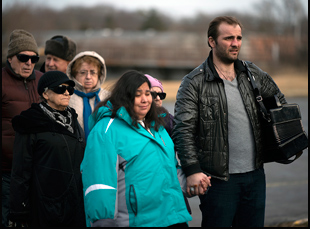
This city has an incredible authenticity to it and it’s like the backbone of America. It’s ethnically very diverse, architecturally evocative, but could double for many places in the world. It’s beautiful. It has its own smell, it’s own air smell and feel in the streets, especially when it’s shrouded in clouds and in fog. It’s really beautiful and rich and before we rolled one single line, we knew we would be making it in Milwaukee with non-actors. That was not to change and that predetermined the destiny of the film. In October 2017, we had an offer from a local billionaire to make the film in Detroit and he was ready to come in with a full budget and we refused to do that – how insane, right? – but we really were proud to stick to our guns and making it in the city that inspired it. We knew that if we took it anywhere else, we would’ve betrayed the spirit, so we made it here with the actors that we cast in the streets at the Wisconsin African-American Community Center — the head of the center is Josephine Hill — and with the Eisenhower Center for Work and Training for People with Disabilities — Barbara Rowland and David Ordan. These were our partners.
It complicated our story immensely because for three-plus years, no one wanted to invest in the film set in Milwaukee with non-actors. No one thought it was commercially interesting or interesting at all period and moreover, once the film was made, at Sundance, many midlevel executives found it unmarketable for that same reason. They said, “Lovely film. We don’t know how to market it,” which we very well know what it stands for because we have a [unknown] African-American [lead] with a disability that they assume the American people will not be [interested in] watching, and at some point, we wanted a poster that contained all the quotes from the people who were denying the existence of “Give Me Liberty” and these are the quotes, “Unproduceable,” “Uncastable” “Preemptively Screwed,” “No way you’ll get to set,” “You have a lovely film, but no chance to get into at Sundance.” At Sundance, it was called “Unmarketable,” “Unreleasable,” “Undistributable.”
After three years of looking for money, we finally found partners in New York that brought us investors, however it wasn’t the right fit and Alice and I had looked at each other — it had been the full three-and-a-half years of pushing that boulder up the hill and we understood we had to make it now or it’s never going to be made. And if we walked away at that point from the project, a lot of people would understand, but we would never forgive each other and we would never be able to look in the eye anybody that trusted us and to whom we had made promises. So we went ahead and shot it for one-third of the [planned] budget.
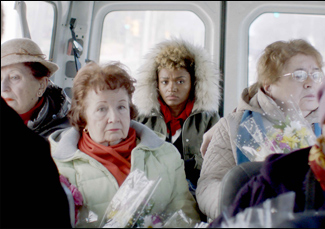
Well, if everything was on paper, there would be no point of making a film and of course, for me a screenplay is a blueprint, especially when you work in real locations in Milwaukee with 99% nonactors, people who had never been in front of the camera. You’re bound to have surprises. You’re bound to have unpredictable situations. In fact, the whole point of inviting real people was their life packages, what they experienced with their sensibilities, with their vulnerabilities, with their unpredictability and [what they may] lack in skill, [they make up for with] their enormous humanity and richness of experience. It’s a technique to achieve what we set out to achieve before we rolled one single line, which is authenticity.
But for 23 days, we fought the hardest war. Every single day, we were set up for enormous disaster. One-third of the cast had disabilities and one-third of our cast is octogenarians who do not speak English, who are in pain constantly – sitting, standing, lying down – it would take them one hour to get on the van and one hour to get off the van. You don’t have the luxury [of time]. You’ve got a get the scene. You’ve got to walk away from the set with the scene, with enough material to edit the film, not just a movie, a world-class movie. We were running for our lives every day. I was not waiting for sparks. We were making them. [laughs] When you have a situation like that, you end up having two-weeks of preproduction instead of two months on the ground breaking [the cast] in. I had one hour – one hour of preparation with my lead actor, and the driver of the van 99.9% of the time was the actor! – We gave him the credit of the stunt driver because he was such a brilliant driver. Never a single accident or incident, nothing. And he had to act and remember lines. And readjust and do take, take, take notes from me as far as, “Turn left, turn right, no, louder, no – more. No, angry. No, this.” It was insane.
We had to put the whole thing on fire and go from zero to 100 in a matter of seconds or we would not have the scene. We had a very incredibly ambitious script for the money we had, for the days we had. We were majorly under crewed and underbudgeted and we knew it was our last chance to do anything because our elderly actors were not getting younger, and people were losing their faith in the project because too much time had passed by. Too many sacrifices had been made. We got to a point when we put [the script] on the backburner [after] a false start, but there were two actors on the ground from the previous cast to make the film already, so we made another film in nine days with them called “Coming to You.” It’s 82 minutes long, a thriller that’s in post-production right now, and when we got back to the [“Give Me Liberty”] script, we hadn’t seen it in a number of months, but we decided to do a major rewrite. Alice, my partner, took a stab at it while I was editing that [other] film and turned a 10-day long story into a 24-hour story, a day in the life, and we [decided we] had to make it when we had to make it with what we had and the number of days we had. So I don’t believe in sparks. I believe in really hard work and maybe if you work hard enough the spark will come as a reward.
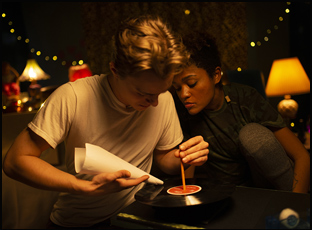
It was a blast. For Alice and I, it was the most gratifying moment of all time, frankly because it all started here and we stuck to our guns for five years, not willing to take it anywhere and we’re very proud of the fact that this is a 100% Milwaukee made film recognized by Sundance, by Cannes – with a 10-minute standing ovation at Cannes! Elton John got tearful after a three-minute standing ovation for Rocketman and Quentin Tarantino, who I adore, his $90 million extravaganza only got seven minutes. And our underdog got 10-plus minutes! We could’ve made 180 films with a standing ovation each. But [our Milwaukee screenings] were sold out. It was packed. It was not just family and friends and colleagues and friends of friends. It was a lot of community leaders, people who believed in us, lots of extras and everyone who actually contributed something to the film. For them, it was just such a reaffirmation of the power of spirit and human determination. A lot of actors with disabilities came with their families. A lot of people cried, a lot of people were moved deeply by the movie, by the situation, by this event. It was truly a moment for Milwaukee to come together, and for Alice and I who have been working on this for such a long time, to have this reaffirmation of the American dream such as “Give Me Liberty” is to be distributed nationally. We fought so many battles in the course of five years and there were so many naysayers, so many negative people who just didn’t care about it or who were just so negative about the whole experience and unwittingly trying to do damage to it that in fighting for this film, it became much more than a motion picture for us. It became our American dream and again, we believe in the American dream is still alive and kicking, especially in Milwaukee.
“Give Me Liberty” opens on August 28th in Los Angeles at the Monica Film Center, the Encino Town Center and the Pasadena Playhouse. A full list of cities and dates can be found here.




